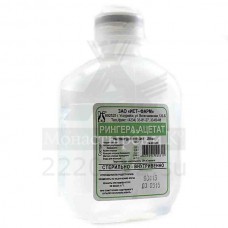Expiration date: 07/2026
Release form, composition and packaging
Solution for infusion transparent, colorless.
250 ml container (32) from the multilayer film based on polypropylene - cardboard boxes.
Clinico-pharmacological group: Drug for rehydration and detoxification for parenteral use
Pharmaco-therapeutic group: Electrolyte balance reducing agent
Pharmacological action
Pharmacokinetics
Testimony
- dehydration and electrolyte imbalance (burns, severe, acute diffuse peritonitis and intestinal obstruction),
- intestinal fistula,
- an acute intestinal infection,
- shock,
- acute blood loss,
- therapeutic plasmapheresis.
The dosage regimen
In/in drip or struino.
Adults: the speed of 60-80 drops/min Daily dose of 5-20 ml/kg, if necessary, can be increased to 30-50 ml/kg.
Children: the rate of administration is 30-60 drops/min Daily dose of 5-10 ml/kg, presolol dehydration of the initially injected 20-30 ml/kg.
The course of treatment is 3-5 days.
In therapeutic plasmapheresis was administered in a volume 2 times the volume of remote plasma (1.2-2.4 l), in the case of severe hypovolemia in combination with colloidal solutions. The maximum volume of injected solution - 3 liters/day.
Side effects
Gipergidratace, hyperkalemia, allergic reactions.
Contraindications
- hypernatremia,
- giperhloremia,
- hyperkalemia,
- acidosis,
- decompensated cardiac insufficiency,
- cerebral edema
- pulmonary edema,
- chronic renal failure,
- concomitant therapy with GCS,
- hypersensitivity.
With caution: arterial hypertension, cardiac insufficiency, especially in the postoperative period or in patients of advanced age, patients receiving cardiac glycosides, while the use of blood products.
Application of pregnancy and breastfeeding
Research of possibility of application of the drug ringer's solution with pregnancy lactation have not been conducted. In this regard, the drug should be used in pregnant women only after the assessment of the benefit/risk, when used in breast-feeding women should refrain from breastfeeding.
Application for violations of renal function
Contraindicated in chronic renal failure.
Special instructions
In the case of rapid injection of a large volume of solution, it is necessary to control the acid-base status and electrolyte concentration. The change in blood pH leads to a redistribution of potassium ion, decrease of pH leads to an increase in the potassium content in the blood serum.
When combined with other drugs it is necessary to visually control the work.
Effects on ability to drive vehicles and management mechanisms
Does not affect the ability to drive vehicles.
Overdose
The introduction of too much solution may cause disruption of fluid balance, electrolytes (hypervolemia, hypernatremia, hyperchloremia) and acid-base balance.
Treatment: symptomatic.
Drug interactions
Potassium-sparing diuretics, potassium supplements, ACE inhibitors increase the risk of hyperkalemia.
Terms and conditions storage
Keep at temperature not exceeding 25°C. Freezing of the drug subject to the preservation of tightness of packing is not a contraindication to its use. After transportation at subzero temperatures the containers in the transport container must be maintained at a temperature of from 15° to 25°C until complete thawing. In the dimness of the contents of the container do not use. Keep out of reach of children.
Shelf life - 2 years. Do not use after the expiry date.
1 vial containe:
sodium chloride solution complex 250 ml
1 liter: sodium chloride 8.6 g
potassium chloride 0.3 g
calcium chloride hexahydrate (anhydrous) 0.25 g
Ion composition (per 1 liter):
Sodium-ion 147.2 mmol/l
Potassium-ion 4.02 mmol/l
Calcium-ion 2.25 mmol/l
Chloride ion 155.7 mmol/l
Theoretical osmolarity 309 mOsm/l


